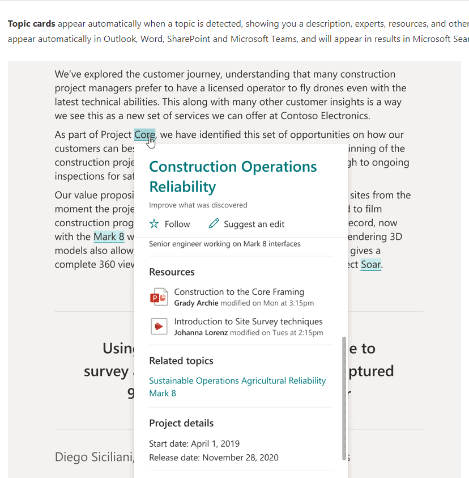Microsoft Aims to Bring AI to Mainstream Collaboration with Project CortexMicrosoft Aims to Bring AI to Mainstream Collaboration with Project Cortex
Project Cortex will let partners build knowledge networks for customers.
November 19, 2019

Microsoft intends to significantly simplify how people find organizational information through internal knowledge networks. It’s via new technology set to appear next year, revealed as Project Cortex.
If Project Cortex works as Microsoft envisions, it will streamline, or in many cases eliminate, the need for individuals to interrupt their work to search for internal information. Project Cortex, introduced at this month’s Microsoft Ignite conference in Orlando, Florida, was a stealth effort in the works for more than two years.
Project Cortex also promises to give Microsoft’s vast partner ecosystem much to digest going into 2020, particularly as customers look to utilize it to enhance their collaboration and employee productivity efforts and Microsoft begins offering training and enablement for partners.
Company officials described Project Cortex as the first major new productivity and collaboration service planned for Microsoft 365 since the launch of Microsoft Teams three years ago. Microsoft CEO Satya Nadella underscored the notion of bringing more seamless access to knowledge in context of whatever application a user is working in is a critical next step forward for the Microsoft 365 platform.
“Project Cortex takes what is data today inside of your organization and converts it into knowledge,” Nadella said during his Ignite keynote session.
Under development by the Microsoft SharePoint team alongside adjacent Office groups including Teams, Yammer and Outlook, Project Cortex uses the company’s AI, advances in Microsoft Search and its Graph APIs to create organizational knowledge networks that will enable customers to automatically surface collective information.
Project Cortex is scheduled to appear in Office, Dynamics and other connected applications in the first half of 2020. It’s not a product itself; rather, Project Cortex will apply its advances in artificial intelligence (AI) and machine learning, drawing on the Microsoft Graph APIs.

A topic card with resources appears when a user hovers over an acronym.
Using the Microsoft Graph, individuals will be able to find organizational information contextually, without switching applications. For example, Microsoft demonstrated at Ignite how a user can scroll over an acronym in any Office app to get a definition of what that acronym means through a topic card that appears without interrupting the reader’s flow, which inevitably occurs when searching for it in some other application.
“You now have AI-driven topics, so essentially you have AI creating topic wikis inside the enterprise,” Nadella said. “You have that ability now, in the context of any document or any email. More interestingly, you can find the experts who know something about that acronym, and you can really integrate and interact with them.”
Building on SharePoint
Project Cortex will automatically use metadata that resides in distributed repositories in what Microsoft’s SharePoint team described as the next generation of core enterprise content management (ECM) services.
Chris McNulty, Microsoft’s senior product manager for Project Cortex, who works on the SharePoint team, underscored that Project Cortex is not a new platform, but rather building on the existing Microsoft 365 and SharePoint platforms.
“We’re able to reach left to right across the suite to be able to invoke the best on top of our platform [by] doing things with security, doing things with compliance [and] doing things with search,” McNulty said during an Ignite session that provided an overview of Project Cortex.
McNulty noted that all of these capabilities will bring together and invoke the metadata within those specific services. For instance, with Microsoft Information Protection, Project Cortex will extract key metadata that can attach and invoke policies based on the value of a contract, he said.
Designed to Combat Knowledge Drain

Microsoft’s Seth Patton earlier this month at Ignite 2019.
Seth Patton, general manager of Microsoft’s Office 365 marketing group, said during a briefing at Ignite that the company spent time with 25 customers in the development of Project Cortex, and 13 organizations are testing it a private technical preview. Patton said Project Cortex is centered around a common problem facing organizations – “knowledge drain” – the consequence of those with expertise leaving an organization.
“That knowledge is walking out the door,” Patton said.
While acknowledging that’s a problem that has long faced all organizations, Patton said the need for making internal knowledge more readily available with the appropriate controls to protect it is becoming more critical. What’s driving that acceleration, he noted, is …
… the rapid shift in workface demographics from retiring baby boomers, the common embrace of flextime and mobility, and the so-called “gig economy.”’
Priming Partners for Project Cortex
The notion of bringing AI into the mainstream will become a key imperative for Microsoft’s vast network of partners.
Patton said Microsoft has so far worked closely with 16 partners who started NDA training last month.
“We’ll continue to expand that out,” he said, when asked by Channel Futures. “The big real formal readiness push for partners will be at Inspire next year just after it goes [to general availability].”
While Microsoft isn’t revealing who those partners are, there are the some obvious suspects. Among them is Accenture and the two companies’ Avanade venture. Aaron Reich, global lead for emerging technologies at Avanade, said Project Cortex addresses a key requirement among its clients.

Avanade’s Aaron Reich earlier this month at Microsoft Ignite 2019.
“If I have information that is spread across images, videos, blog posts, document and PDFs, to be able to take all of that and tie those things together becomes extremely powerful,” Reich told Channel Futures.
Reich gave an example of how it was working with one of its financial services customers and Microsoft’s cognitive search team to help financial planners gather more information faster.
“By moving the information from a different knowledge store and feeding everything into Azure, we were able to actually reduce the time of finding that information,” he said.
“From a business perspective, Microsoft is trying to really get people in organizations to think differently about what the tools they use can do,” said Carolina Milanesi, a principal analyst at Creative Strategies.
Patrick Moorhead, chief analyst and founder of Moor Insights and Technology, said Project Cortex has the potential to make AI more meaningful in everyday work processes.
“It’s one thing to know what you’re looking for and then and then having it surface, but it’s another where things find inner-relation between projects people have worked on, searches that they’re doing and the type of work that they’re working on. It’s almost predictive — knowing what you want before you actually want it,” Moorhead said. “I put it under the ‘it sounds too good to be true’ category.”
Extending Microsoft Search
The new Microsoft Search capabilities announced at Ignite will be a key component of Project Cortex. Microsoft is putting significant resources into improving its search tool including support for natural language processing. Also at Ignite, Microsoft said it is looking to extend its search tool to third party sources and internal enterprise knowledge repositories.
The company announced the technical preview release of 100 connectors from various partners including Accenture, BA Insight, Raytion, Salesforce, SAP and ServiceNow. The connectors will bring information to Microsoft 365 that the company said are automatically discoverable throughout the various apps as well as through Bing search and the Edge browser.
The Fluid Framework
Another key deliverable alongside Project Cortex and the search enhancements is Microsoft’s Fluid Framework user experience, technology revealed during the Microsoft Build conference for developers in May. The Fluid Framework will allow multi-person co-authoring at scale of documents and web content. (Microsoft also has launched a private preview for the Fluid Framework developer environment.)
Microsoft officials characterized the Fluid Framework as conceptually similar to its SharePoint Framework but designed with a component document model that lets each user break it down into more flexible content. The Fluid Framework also enables intelligent agents, or bots, to facilitate content creation by helping authors access content, translate text, recommend edits and ensure compliance, among other tasks.
Read more about:
AgentsAbout the Author
You May Also Like


